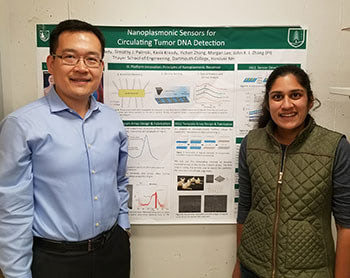- Undergraduate
Bachelor's Degrees
Bachelor of ArtsBachelor of EngineeringPartner School Dual-DegreeUndergraduate AdmissionsUndergraduate Experience
- Graduate
Doctoral Degrees
Doctor of PhilosophyPhD Innovation ProgramDoctor of Medicine-PhDGraduate AdmissionsGraduate Experience
- Research
- Entrepreneurship
- Community
- About
-
All Thayer News

Professor John Zhang (left) and graduate student Amogha Tadimety (right) designed and engineered a gold nanorod probe sensor that binds to mutated DNA circulating in blood and could potentially be used for earlier detection of pancreatic cancer.
What's Happening with Pancreatic Cancer Research at NCCC?
Dec 04, 2017 | by Lara Stahler | NCCC
The pancreas is a six-inch long narrow organ that sits behind the stomach—kind of shaped like a fish with a “head” and a “tail,”—and functions as part of the digestive system. It produces pancreatic enzymes to aid in digestion and insulin to control blood sugar. For a fairly small organ, it is the source of a largely difficult cancer.
The challenges of pancreatic cancer
The American Cancer Society estimates that more than 53,600 people in the United States will be diagnosed with pancreatic cancer in 2017, with a death rate of about 80 percent. Pancreatic cancer accounts for about 3 percent of all cancers in the US and about 7 percent of all cancer deaths. Risk factors are difficult to identify, there are no or very subtle symptoms such as sudden-onset diabetes, and it remains one of the most challenging cancers to detect and diagnose early.
“Sixty percent of the cases we see are already Stage 4. Unfortunately, there isn’t a known cure at that stage,” explains Kerrington Smith, MD, division chief of Surgical Oncology, and member of the Molecular Therapeutics Research Program at Dartmouth-Hitchcock’s Norris Cotton Cancer Center (NCCC). “Pancreatic cancer just surpassed breast cancer as the third leading cause of cancer-related deaths and by 2020 is projected to surpass colon cancer as the second leading cause. It’s because other cancers have better treatment options,” he says. ...
... Finding it sooner
Presently, pancreatic cancer can only be detected after solid tumors have formed, which usually means the disease has already progressed to a later stage. One way to possibly reduce the mortality rate of pancreatic cancer is if it could be detected, diagnosed and treated much sooner, even before visible tumors form. In 2016, the research team led by Gregory Tsongalis, PhD, director of the Laboratory for Clinical Genomics and Advanced Technology (CGAT) and member of NCCC’s Molecular Therapeutics Research Program, received a Prouty Pilot grant to research liquid biomarkers, or circulating tumor DNA (ctDNA) in the bloodstream, before they progress to tumors. “We’re working on novel technologies to detect ctDNA in the plasma of cancer patients,” says Tsongalis. “We’re developing optimized protocols to isolate ctDNA from plasma samples and then assessing various molecular technologies to search for genetic variants that may be of clinical interest.”

Professor John Zhang (left) and graduate student Amogha Tadimety (right) designed and engineered a gold nanorod probe sensor that binds to mutated DNA circulating in blood and could potentially be used for earlier detection of pancreatic cancer.
Working with Dartmouth’s Thayer School of Engineering, Tsongalis’ team developed a concept of nanorod probe sensors to capture circulating tumor or mutant DNA in the blood. The first year of the Prouty grant was dedicated in part to engineering and design of the nanorod sensor, led by John Zhang, PhD, Professor of Engineering at Thayer, and Amogha Tadimety, BSE, a graduate student and PhD Innovation Fellow.
The team engineered a system of gold nanorods affixed with recognition element probes designed to selectively bind to a complementary sequence of DNA. When white light is shone on the gold nanorods, they absorb most of the light at a particular wavelength, and when something is bound to the nanorods, that wavelength shifts. The team can use a read-out that shows a measured shift in wavelength peaks to determine if the nanorod sensor has bound to something, indicating a mutation in that DNA. This process happens within minutes and can measure down to a single molecule bound to a single nanorod. For perspective, 1,000 nanorods could fit on the end of a strand of hair.
“This biomarker, circulating DNA, has been shown to be present in the blood well before a tumor shows up on imaging. But the DNA is in such low concentration that it’s hard to capture and detect them and requires a lot of equipment and technical expertise,” says Tadimety. “Our technology is as simple as flowing a tiny amount of blood through a small device and taking a measurement. We want to know both the concentration of DNA and what percentage of it is mutated. That’s what we’d need to know to make a diagnosis. The results are promising so far, showing that the nanorods are selectively binding to more of the mutated DNA than the wild-type.”
As engineering progresses, Tadimety and Zhang are working on altering the probe to increase further its preferential binding to mutant DNA over wild-type. “My team continues to look at genetic variants (mutations) in pancreatic cancer and how that impacts tumor development, progression and response to therapy as part of our precision medicine initiative,” explains Tsongalis. “We are also actively looking at new biomarkers for this dreadful disease.”
Link to source:
For contacts and other media information visit our Media Resources page.
